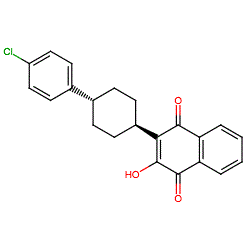GtoPdb is requesting financial support from commercial users. Please see our sustainability page for more information.
|
Synonyms: 566C80 | Mepron® | Wellvone®
atovaquone is an approved drug (FDA (1992))
Compound class:
Synthetic organic
Comment: Atovaquone is a synthetic hydroxynaphthoquinone with broad-spectrum antiprotozoal activity. It is an antimalarial drug and used in combination with proguanil.
Note that we have drawn the molecule as specified by the INN record and ChEMBL entry listed on this summary page. The structure for PubChem CID 74989 (link in table below) is shown without specified stereochemistry (InChi Key BSJMWHQBCZFXBR-UHFFFAOYSA-N). Ligand Activity Visualisation ChartsThese are box plot that provide a unique visualisation, summarising all the activity data for a ligand taken from ChEMBL and GtoPdb across multiple targets and species. Click on a plot to see the median, interquartile range, low and high data points. A value of zero indicates that no data are available. A separate chart is created for each target, and where possible the algorithm tries to merge ChEMBL and GtoPdb targets by matching them on name and UniProt accession, for each available species. However, please note that inconsistency in naming of targets may lead to data for the same target being reported across multiple charts. ✖ |
|
|||||||||||||||||||||||||||||||||||
| References |
|
1. Boggild AK, Parise ME, Lewis LS, Kain KC. (2007)
Atovaquone-proguanil: report from the CDC expert meeting on malaria chemoprophylaxis (II). Am J Trop Med Hyg, 76 (2): 208-23. [PMID:17297027] |
|
2. Canfield CJ, Pudney M, Gutteridge WE. (1995)
Interactions of atovaquone with other antimalarial drugs against Plasmodium falciparum in vitro. Exp Parasitol, 80 (3): 373-81. [PMID:7729473] |
|
3. Delves M, Plouffe D, Scheurer C, Meister S, Wittlin S, Winzeler EA, Sinden RE, Leroy D. (2012)
The activities of current antimalarial drugs on the life cycle stages of Plasmodium: a comparative study with human and rodent parasites. PLoS Med, 9 (2): e1001169. [PMID:22363211] |
|
4. Fisher N, Abd Majid R, Antoine T, Al-Helal M, Warman AJ, Johnson DJ, Lawrenson AS, Ranson H, O'Neill PM, Ward SA et al.. (2012)
Cytochrome b mutation Y268S conferring atovaquone resistance phenotype in malaria parasite results in reduced parasite bc1 catalytic turnover and protein expression. J Biol Chem, 287 (13): 9731-41. [PMID:22282497] |
|
5. Hughes W, Leoung G, Kramer F, Bozzette SA, Safrin S, Frame P, Clumeck N, Masur H, Lancaster D, Chan C et al.. (1993)
Comparison of atovaquone (566C80) with trimethoprim-sulfamethoxazole to treat Pneumocystis carinii pneumonia in patients with AIDS. N Engl J Med, 328 (21): 1521-7. [PMID:8479489] |
|
6. Krause PJ, Lepore T, Sikand VK, Gadbaw Jr J, Burke G, Telford 3rd SR, Brassard P, Pearl D, Azlanzadeh J, Christianson D et al.. (2000)
Atovaquone and azithromycin for the treatment of babesiosis. N Engl J Med, 343 (20): 1454-8. [PMID:11078770] |
|
7. Looareesuwan S, Viravan C, Webster HK, Kyle DE, Hutchinson DB, Canfield CJ. (1996)
Clinical studies of atovaquone, alone or in combination with other antimalarial drugs, for treatment of acute uncomplicated malaria in Thailand. Am J Trop Med Hyg, 54 (1): 62-6. [PMID:8651372] |
|
8. Painter HJ, Morrisey JM, Mather MW, Vaidya AB. (2007)
Specific role of mitochondrial electron transport in blood-stage Plasmodium falciparum. Nature, 446 (7131): 88-91. [PMID:17330044] |
|
9. Srivastava IK, Rottenberg H, Vaidya AB. (1997)
Atovaquone, a broad spectrum antiparasitic drug, collapses mitochondrial membrane potential in a malarial parasite. J Biol Chem, 272 (7): 3961-6. [PMID:9020100] |
|
10. Vaidya AB, Lashgari MS, Pologe LG, Morrisey J. (1993)
Structural features of Plasmodium cytochrome b that may underlie susceptibility to 8-aminoquinolines and hydroxynaphthoquinones. Mol Biochem Parasitol, 58 (1): 33-42. [PMID:8459834] |









